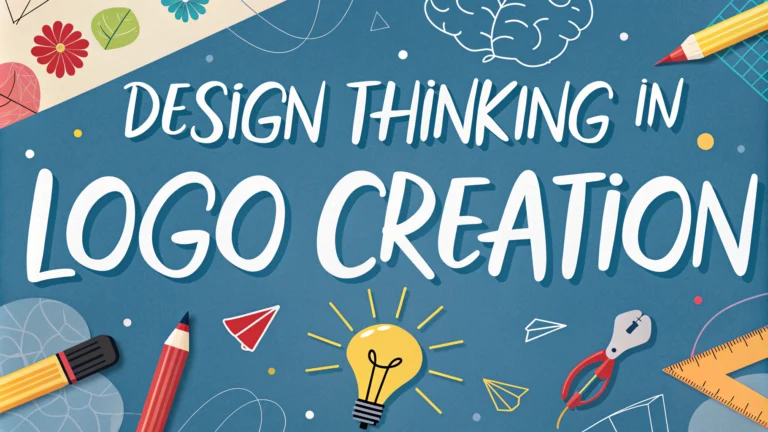Design thinking transforms logo creation from a purely artistic endeavor into a strategic problem-solving process.
Understanding Design Thinking in Logo Design
The design thinking approach follows five key stages: Empathize, Define, Ideate, Prototype, and Test.
- Empathize: Research your client’s audience, industry, and competitors
- Define: Identify specific brand challenges and goals
- Ideate: Sketch multiple concepts and explore various directions
- Prototype: Create refined versions of the most promising ideas
- Test: Gather feedback and refine based on real-world application
Practical Applications
Each logo project starts with thorough research into the client’s target market and competition.
| Research Area | Key Questions |
|---|---|
| Target Audience | Who are they? What appeals to them? |
| Competition | What visual elements are common in the industry? |
| Brand Values | What message needs to be conveyed? |
Tools and Resources
- Research Tools:
- Pinterest for mood boards
- Behance for inspiration
- Google Forms for client questionnaires
- Design Software:
- Adobe Illustrator
- Figma
- Sketch
Testing and Validation
Test your logo designs across multiple platforms and sizes before finalizing.
- Social media profile pictures
- Business cards
- Website headers
- Mobile app icons
- Print materials
Common Mistakes to Avoid
- Skipping the research phase
- Following trends blindly
- Creating overly complex designs
- Neglecting scalability
- Rushing through iterations
Contact professional logo design associations like AIGA (www.aiga.org) for additional resources and networking opportunities.
Schedule regular check-ins with clients throughout the design process to ensure alignment with their vision and goals.
Quick Tips for Success
- Keep detailed notes during client meetings
- Create simple sketches before moving to digital
- Test logos in black and white first
- Save multiple versions for different applications
- Document your design process for future reference
Measuring Success
Success in logo design extends beyond aesthetic appeal to measurable business impact.
- Brand recognition rates
- Social media engagement
- Client satisfaction scores
- Market differentiation
- Implementation ease
Implementation Strategy
A successful logo rollout requires careful planning and coordination across all brand touchpoints.
| Touchpoint | Implementation Considerations |
|---|---|
| Digital Presence | Website, social media, email signatures |
| Physical Materials | Signage, packaging, uniforms |
| Marketing Collateral | Business cards, brochures, advertisements |
Future-Proofing Your Design
- Versatility Checks:
- Animation potential
- AR/VR applications
- Cross-platform compatibility
- Documentation:
- Brand guidelines
- Usage specifications
- File format inventory
Conclusion
Design thinking transforms logo creation into a systematic, results-driven process that balances creativity with strategic business objectives. Success comes from thorough research, iterative design, and comprehensive testing, ensuring the final logo effectively represents the brand across all current and future applications.
Final Checklist
- Complete brand guidelines documentation
- Prepare all necessary file formats
- Create implementation timeline
- Schedule follow-up review
- Archive research and development materials
FAQs
- What exactly is design thinking in logo creation?
Design thinking in logo creation is a human-centered approach that involves empathizing with the target audience, defining the brand’s core message, ideating multiple concepts, prototyping designs, and testing them with stakeholders to create effective visual identities. - How does the ideation phase work in logo design thinking?
The ideation phase involves brainstorming multiple concepts through sketching, mind mapping, and visual exploration. Designers generate numerous ideas without judgment before narrowing down to the most promising concepts that align with the brand’s objectives. - What role does user research play in design thinking for logos?
User research helps designers understand the target audience’s preferences, cultural contexts, and emotional responses to visual elements. This information guides the creation of logos that resonate with the intended viewers and effectively communicate the brand message. - How many iterations should a logo go through in the design thinking process?
A logo typically goes through 3-5 major iterations during the design thinking process, with numerous minor refinements within each iteration. The exact number depends on client feedback, testing results, and how well the design meets the project objectives. - What tools are essential for implementing design thinking in logo creation?
Essential tools include sketching materials, vector graphic software (like Adobe Illustrator), prototyping tools, collaboration platforms, mood board creators, and user feedback collection tools. - How do you validate a logo design through the design thinking process?
Logo validation involves user testing, stakeholder feedback sessions, A/B testing with target audiences, scalability tests across different mediums, and comparing the design against the initial project brief and brand objectives. - What are the key considerations during the empathy phase of logo design?
The empathy phase focuses on understanding brand values, target audience emotions, cultural significance, market positioning, competitor analysis, and potential use contexts for the logo. - How long should the design thinking process take for logo creation?
A thorough design thinking process for logo creation typically takes 2-4 weeks, including research, ideation, prototyping, and refinement phases. Complex projects may require additional time for proper development and testing. - What makes a logo design solution viable in the design thinking framework?
A viable logo design solution must be technically feasible, aesthetically pleasing, culturally appropriate, versatile across different mediums, memorable, and effectively communicate the brand’s core message while meeting business objectives. - How do you incorporate feedback loops in the logo design thinking process?
Feedback loops are implemented through regular client check-ins, user testing sessions, design team reviews, and stakeholder presentations at key milestones, allowing for continuous improvement and refinement of the logo design.








